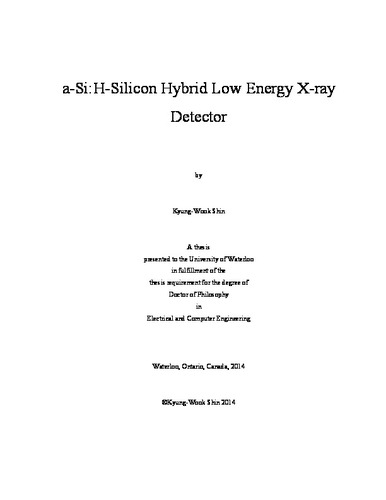| dc.contributor.author | Shin, Kyung-Wook | |
| dc.date.accessioned | 2014-09-15 17:06:00 (GMT) | |
| dc.date.available | 2014-09-15 17:06:00 (GMT) | |
| dc.date.issued | 2014-09-15 | |
| dc.date.submitted | 2014-09-15 | |
| dc.identifier.uri | http://hdl.handle.net/10012/8797 | |
| dc.description.abstract | Low energy X-ray (< 20 keV) detection is a key technological requirement in applications such as protein crystallography or diffraction imaging. Silicon based optical cameras based on CCDs or CMOS imaging chips coupled to X-ray conversion scintillators have become a mainstay in the field. They are attractive because of fast readout capability and ease of integrated circuit implementation due to modern semiconductor fabrication technology. More recently, hydrogenated amorphous silicon (a-Si:H) thin film technology, that had enabled a huge influx of large area display products into the commercial display market, has been introduced to digital imaging in the form of active matrix flat panel imagers (AMFPIs). Although thin film technology can enable large area X-ray imaging at a potentially lower cost, the existing technology lacks spatial resolution requirements for higher performance crystallography and diffraction imaging applications.
This work introduces a high resolution direct conversion silicon X-ray detector integrated with large area thin film silicon technology for sub-20 keV photon X-ray imagers. A prototype pixel was fabricated in-house using a fabrication facility (G2N) utilizing plasma enhanced chemical vapor deposition (PECVD), reactive ion etching (RIE), photo-lithography, and metal sputtering technologies. Unlike most active matrix display products, top-gate staggered a-Si:H thin film transistor (TFT) were implemented to take advantage of a novel thin film silicon pixel amplification device architecture.
The detector performance was evaluated with an iron 55 isotope gamma ray source to mimic low energy X-ray exposure. I-V and C-V measurement techniques indicate that the hybrid pixel functions as expected and is promising for low cost, high resolution, large area X-ray imaging (< 20 keV) applications. We also performed a noise spectrum investigation to estimate the lowest detection signal level limit and proposed a model rooted in device physics for the pixel output and gain. | en |
| dc.language.iso | en | en |
| dc.publisher | University of Waterloo | en |
| dc.subject | Detector | en |
| dc.subject | Thin Film Transistor | en |
| dc.subject | X-ray | en |
| dc.subject | Microfabrication | en |
| dc.subject | Simulation | en |
| dc.subject | TCAD | en |
| dc.subject | PECVD | en |
| dc.subject | Noise | en |
| dc.subject | Characterization | en |
| dc.subject | Silicon | en |
| dc.title | a-Si:H-Silicon Hybrid Low Energy X-ray Detector | en |
| dc.type | Doctoral Thesis | en |
| dc.pending | false | |
| dc.subject.program | Electrical and Computer Engineering | en |
| uws-etd.degree.department | Electrical and Computer Engineering | en |
| uws-etd.degree | Doctor of Philosophy | en |
| uws.typeOfResource | Text | en |
| uws.peerReviewStatus | Unreviewed | en |
| uws.scholarLevel | Graduate | en |

